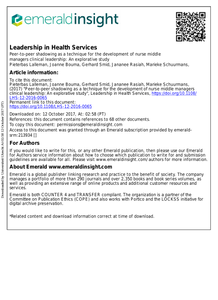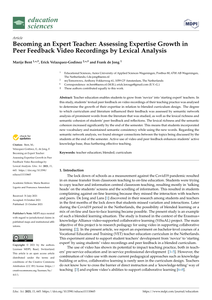The first year of study is very exciting for many students. Everything is new: the school, your schedule, the teachers, and your fellow students. How can a university ensure a smooth transition for first-year students? For this, Inholland launched the Students for Students (S4S) project in the 2019-2020 academic year. In this project, second-year students (studentcoaches) support first-year students with their studies. They do this based on their own experience and the training they receive during their year as studentcoaches. Research shows that peer-mentoring is very successful in aiding first-year students through their first year of the study program. Peer-mentoring has the potential to increase well-being, social bonding, the feeling of belonging, and student resilience. It also ensures smoother academic integration, as peer-mentoring focuses on developing academic skills as well. Additionally, a studentcoach is often a low threshold point of contact for students where they can go with questions.
DOCUMENT

Just what and how eight experienced teachers in four coaching dyads learned during a 1-year reciprocal peer coaching trajectory was examined in the present study. The learning processes were mapped by providing a detailed description of reported learning activities, reported learning outcomes, and the relations between these two. The sequences of learning activities associated with a particular type of learning outcome were next selected, coded, and analyzed using a variety of quantitative methods. The different activity sequences undertaken by the teachers during a reciprocal peer coaching trajectory were found to trigger different aspects of their professional development.
DOCUMENT

From the article: "Whilst the importance of online peer feedback and writing argumentative essays for students in higher education is unquestionable, there is a need for further research into whether and the extent to which female and male students differ with regard to their argumentative feedback, essay writing, and content learning in online settings. The current study used a pre-test, post-test design to explore the extent to which female and male students differ regarding their argumentative feedback quality, essay writing and content learning in an online environment. Participants were 201 BSc biotechnology students who wrote an argumentative essay, engaged in argumentative peer feedback with learning partners in the form of triads and finally revised their original argumentative essay. The findings revealed differences between females and males in terms of the quality of their argumentative feedback. Female students provided higher-quality argumentative feedback than male students. Although all students improved their argumentative essay quality and also knowledge content from pre-test to post-test, these improvements were not significantly different between females and males. Explanations for these findings and recommendations are provided"
MULTIFILE

The purpose of this study was to explore the experiences and impact of peer-to-peer shadowing as a technique to develop nurse middle managers’ clinical leadership practices. A qualitative descriptive study was conducted to gain insight into the experiences of nurse middle managers using semi-structured interviews. Data were analysed into codes using constant comparison and similar codes were grouped under sub-themes and then into four broader themes. Peer-to-peer shadowing facilitates collective reflection-in-action and enhances an “investigate stance” while acting. Nurse middle managers begin to curb the caring disposition that unreflectively urges them to act, to answer the call for help in the here and now, focus on ad hoc “doings”, and make quick judgements. Seeing a shadowee act produces, via a process of social comparison, a behavioural repertoire of postponing reactions and refraining from judging. Balancing the act of stepping in and doing something or just observing as well as giving or withholding feedback are important practices that are difficult to develop.
DOCUMENT

A considerable amount of literature on peer coaching suggests that the professional development of teachers can be improved through experimentation, observation, reflection, the exchange of professional ideas, and shared problem-solving. Reciprocal peer coaching provides teachers with an opportunity to engage in such activities in an integrated form. Even though empirical evidence shows effects of peer coaching and teacher satisfaction about coaching, the actual individual professional development processes have not been studied extensively. This article offers a way to analyze and categorize the learning processes of teachers who take part in a reciprocal peer coaching trajectory by using the Interconnected Model of Teacher Professional Growth as an analytical tool. Learning is understood as a change in the teacher's cognition and/or behavior. The assumption underlying the Interconnected Model of Teacher Professional Growth is that change occurs in four distinct domains that encompass the teacher's professional world: the personal domain, the domain of practice, the domain of consequence and the external domain. Change in one domain does not always lead to change in another, but when changes over domains do occur, different change patterns can be described. Repeated multiple data collection methods were used to obtain a rich description of patterns of change of four experienced secondary school teachers. The data sources were: audiotapes of coaching conferences, audiotapes of semi-structured learning interviews by telephone, and digital diaries with teacher reports of learning experiences. Qualitative analysis of the three data sources resulted in two different types of patterns: including the external domain and not including the external domain. Patterns of change within a context of reciprocal peer coaching do not necessarily have to include reciprocal peer coaching activities. When, however, patterns do include the external reciprocal peer coaching domain, this is often part of a change process in which reactive activities in the domains of practice and consequence are involved as well. These patterns often demonstrate more complex processes of change.
DOCUMENT

Teacher education enables students to grow from ‘novice’ into ‘starting expert’ teachers. In this study, students’ textual peer feedback on video recordings of their teaching practice was analysed to determine the growth of their expertise in relation to blended curriculum design. The degree to which curriculum and literature influenced their feedback was assessed by semantic network analysis of prominent words from the literature that was studied, as well as the lexical richness andsemantic cohesion of students’ peer feedback and reflections. The lexical richness and the semantic cohesion increased significantly by the end of the semester. This means that students incorporated new vocabulary and maintained semantic consistency while using the new words. Regarding the semantic network analysis, we found stronger connections between the topics being discussed by the students at the end of the semester. Active use of video and peer feedback enhances students’ activeknowledge base, thus furthering effective teaching.
DOCUMENT

This dissertation presents the results of a research project on unraveling the dynamics of facilitating workplace learning through pedagogic practices in healthcare placements. Supervisors are challenged to foster safe learning opportunities and fully utilize the learning potential of placement through stimulating active participation for students while ensuring quality patient care. In healthcare placements, staff shortages and work pressure may lead to stress when facilitating workplace learning. Enhancing pedagogic practices in healthcare placements seems essential to support students in challenging experiences, such as emotional challenges. This dissertation proposes approaches for optimizing learning experiences for students by highlighting the value of day-to-day work activities and interactions in healthcare placements, and shedding light on agency in workplace learning through supervisor- and student-strategies.
DOCUMENT

Background: Shared decision-making is one key element of interprofessional collaboration. Communication is often considered to be the main reason for inefficient or ineffective collaboration. Little is known about group dynamics in the process of shared decision-making in a team with professionals, including the patient or their parent. This study aimed to evaluate just that. Methods: Simulation-based training was provided for groups of medical and allied health profession students from universities across the globe. In an overt ethnographic research design, passive observations were made to ensure careful observations and accurate reporting. The training offered the context to directly experience the behaviors and interactions of a group of people. Results: Overall, 39 different goals were defined in different orders of prioritizing and with different time frames or intervention ideas. Shared decision-making was lacking, and groups chose to convince the parents when a conflict arose. Group dynamics made parents verbally agree with professionals, although their non-verbal communication was not in congruence with that. Conclusions: The outcome and goalsetting of an interprofessional meeting are highly influenced by group dynamics. The vision, structure, process, and results of the meeting are affected by multiple inter- or intrapersonal factors.
DOCUMENT

Hoofdstuk 2 gaat over peer en professionele online support voor ouders bij het opvoeden. In totaal bevat het boek 31 hoofdstukken over sociaal netwerken, geschreven door tientallen onderzoekers wereldwijd.
MULTIFILE

Youths in Bolgatanga municipality in the Upper East Region in the rural north of Ghana suffer health and social problems that are caused by their premarital and unsafe sexual behaviour. This study provides more knowledge of and insight into the youths’ conceptions, motives and practices concerning premarital sex in the specific cultural and social context of Bolgatanga municipality. The results of this study can contribute to the development of more effective sexual and reproductive health (SRH) programmes. Interviews with 33 youths and 27 key respondents were carried out. Four repertoires were constructed to present the dynamics wherein the youths’ premarital sexual behaviour takes place. The dominant ideology of abstaining from premarital sex contrasts with the counter ideology of allowing premarital sex, influenced by increasing modernization. SRH programmes should take into account the increasing influence of modernity, gender differences and the compelling influence of peer groups, all of which contribute to youths engaging in premarital sex, with health and social problems as possible consequences. (Afr J Reprod Health 2013; 17[4]: 93-106).
DOCUMENT
